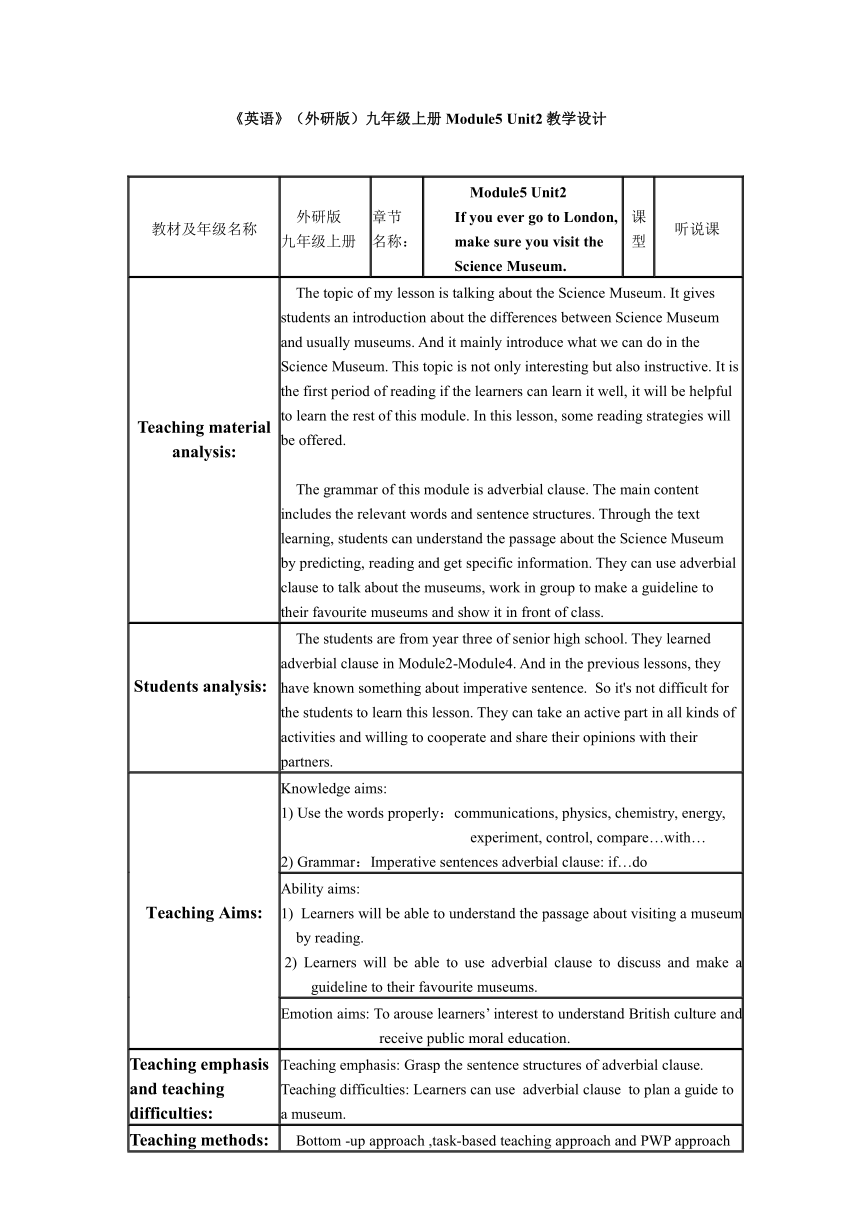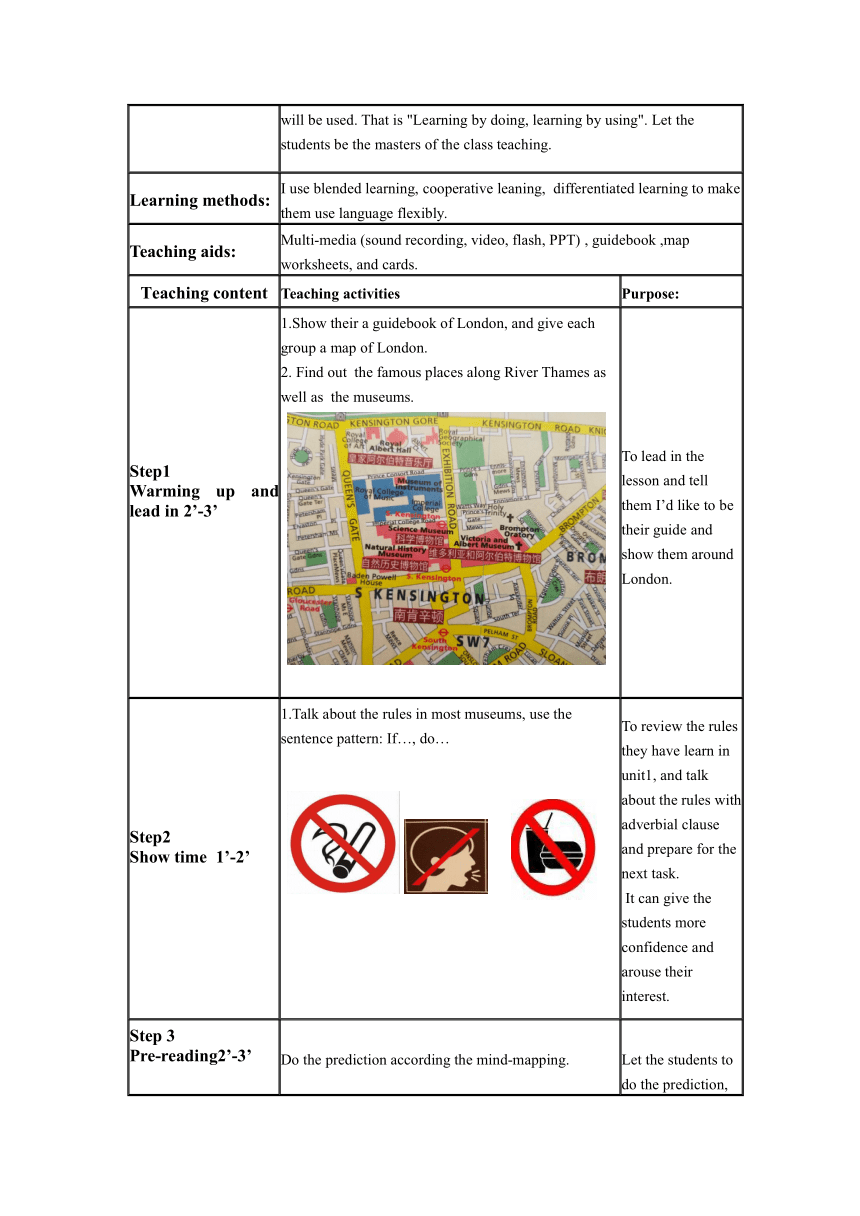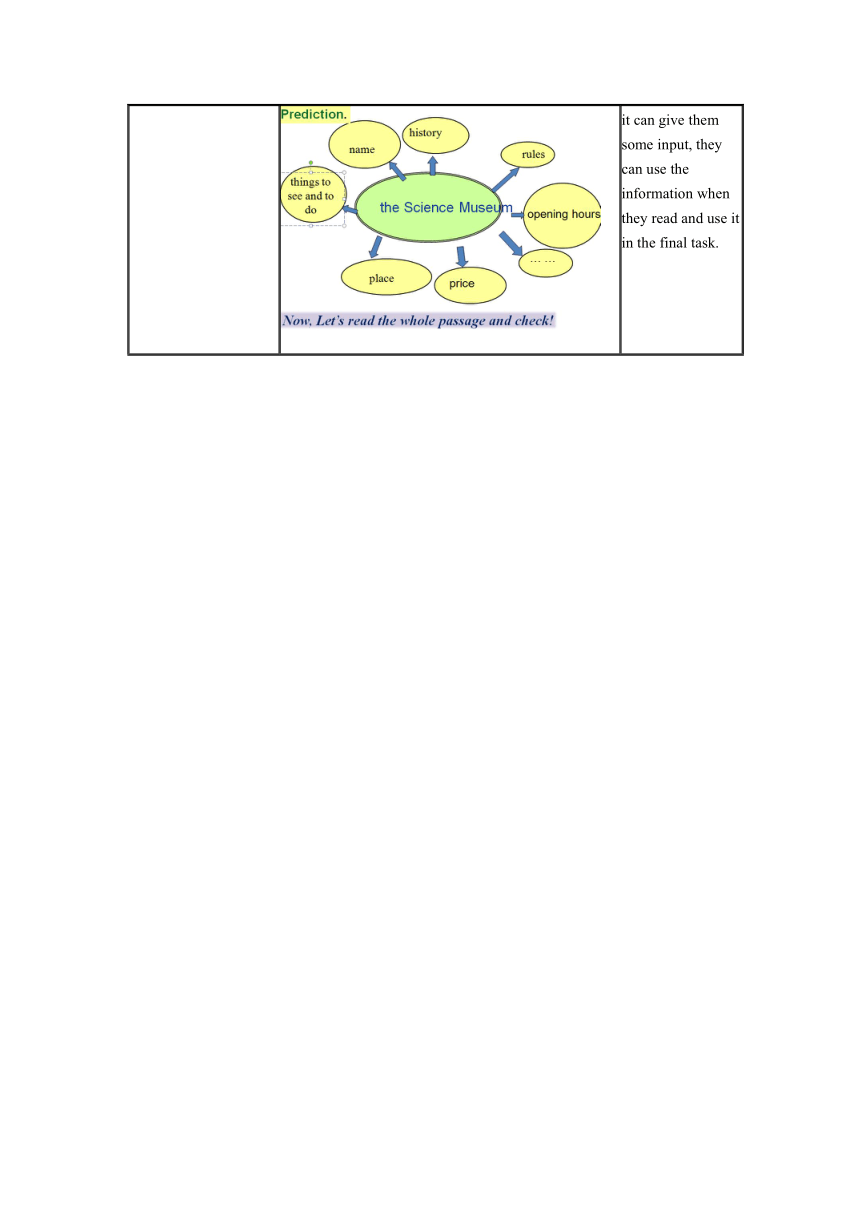外研版九上英语 Module 5 Museums Unit 2 教案(表格式)
文档属性
| 名称 | 外研版九上英语 Module 5 Museums Unit 2 教案(表格式) |  | |
| 格式 | doc | ||
| 文件大小 | 2.1MB | ||
| 资源类型 | 教案 | ||
| 版本资源 | 外研版 | ||
| 科目 | 英语 | ||
| 更新时间 | 2022-09-16 11:33:43 | ||
图片预览



文档简介
《英语》(外研版)九年级上册Module5 Unit2教学设计
教材及年级名称 外研版九年级上册 章节名称: Module5 Unit2 If you ever go to London, make sure you visit the Science Museum. 课型 听说课
Teaching material analysis:
The topic of my lesson is talking about the Science Museum. It gives students an introduction about the differences between Science Museum and usually museums. And it mainly introduce what we can do in the Science Museum. This topic is not only interesting but also instructive. It is the first period of reading if the learners can learn it well, it will be helpful to learn the rest of this module. In this lesson, some reading strategies will be offered.The grammar of this module is adverbial clause. The main content includes the relevant words and sentence structures. Through the text learning, students can understand the passage about the Science Museum by predicting, reading and get specific information. They can use adverbial clause to talk about the museums, work in group to make a guideline to their favourite museums and show it in front of class.
Students analysis: The students are from year three of senior high school. They learned adverbial clause in Module2-Module4. And in the previous lessons, they have known something about imperative sentence. So it's not difficult for the students to learn this lesson. They can take an active part in all kinds of activities and willing to cooperate and share their opinions with their partners.
Teaching Aims: Knowledge aims:1) Use the words properly:communications, physics, chemistry, energy, experiment, control, compare…with… 2) Grammar:Imperative sentences adverbial clause: if…do
Ability aims:1) Learners will be able to understand the passage about visiting a museum by reading. 2) Learners will be able to use adverbial clause to discuss and make a guideline to their favourite museums.
Emotion aims: To arouse learners’ interest to understand British culture and receive public moral education.
Teaching emphasis and teaching difficulties: Teaching emphasis: Grasp the sentence structures of adverbial clause.Teaching difficulties: Learners can use adverbial clause to plan a guide to a museum.
Teaching methods: Bottom -up approach ,task-based teaching approach and PWP approach will be used. That is "Learning by doing, learning by using". Let the students be the masters of the class teaching.
Learning methods: I use blended learning, cooperative leaning, differentiated learning to make them use language flexibly.
Teaching aids: Multi-media (sound recording, video, flash, PPT) , guidebook ,map worksheets, and cards.
Teaching content Teaching activities Purpose:
Step1Warming up and lead in 2’-3’ 1.Show their a guidebook of London, and give each group a map of London.2. Find out the famous places along River Thames as well as the museums. To lead in the lesson and tell them I’d like to be their guide and show them around London.
Step2 Show time 1’-2’ 1.Talk about the rules in most museums, use the sentence pattern: If…, do… To review the rules they have learn in unit1, and talk about the rules with adverbial clause and prepare for the next task. It can give the students more confidence and arouse their interest.
Step 3Pre-reading2’-3’ Do the prediction according the mind-mapping. Let the students to do the prediction,it can give them some input, they can use the information when they read and use it in the final task.
Step4 While-reading 12’-15’ Task1 Fast reading What does the writer talk about in each part (Match)Reading Tips:1. Predictions.(预测).2.Pay attention to the first and last sentences.Task2 Careful reading1.Read paragragh1 and check the prediction. Find out the rules between most usual museums and the Science Museum.2.Listen to the second paragraph and answer the questions.a. What can you learn about in the rooms on the second and third floors b. What allows you to see inside your body A. X-ray B. maths C. physicsc. You can find out how people_____ coal ____the ground and use it to create the energy.Words: In this part, I will show the students some reading strategies and them good ways to learn the new words by themselves. 3.Read paragraph 4&plete the table.b. Check T or F. 1.By reading the passage, let the learners know that different museums have different rules.2. To train the students' ability to gather information. 3. In this part, I will show the students some reading strategies and them good ways to learn the new words by themselves. 4To make it easy for the whole class to understand the passage.5.Use the table to make the passage clearer. Try to use if…do…as much as possible.
Step 5 Post- reading 2’-3’ 1. How many floors are there in the Science Museum (Add more information that they can’t learn in the book.)2. Achieve moral aims.(Museum collections make connections.博物馆藏品架起沟通的桥梁.) 1.Make them know more information about the Science Museum.
Step6Practice time2’-3’ Look at the map that we use at the beginning of the class, show them 3 pictures in different places let them practice with the pattern: if…do… By doing these exercises, let Ss know more clearly about the usage of adverbial clause.
Step7 Final task 10’-13’ Let’s PK! Be an excellent guide!Work in group and choose a museum to introduce.Try their best to use the sentence structure: if…dothen give a report.At last, vote to choose the best guide! Let the students use the words, phrases and adverbial clause to write a short passage.They can also use the sentence structure to show their opinions.
Step8Summary 2’ I will use mind-mapping to sum up what they have learnt in this class. Give the Ss a clear idea of this class.
Blackboard design:
Module5 Unit2
If you ever go to London, make sure you visit the Science Museum
3F
2F
experiment
Group1:
Group2:
Group3:
Group4:
Group5:
Group6:
G/F Exhibition Room For Children
1F Watt’s Engine & Power Room
chemistry
…
4F
5F
教材及年级名称 外研版九年级上册 章节名称: Module5 Unit2 If you ever go to London, make sure you visit the Science Museum. 课型 听说课
Teaching material analysis:
The topic of my lesson is talking about the Science Museum. It gives students an introduction about the differences between Science Museum and usually museums. And it mainly introduce what we can do in the Science Museum. This topic is not only interesting but also instructive. It is the first period of reading if the learners can learn it well, it will be helpful to learn the rest of this module. In this lesson, some reading strategies will be offered.The grammar of this module is adverbial clause. The main content includes the relevant words and sentence structures. Through the text learning, students can understand the passage about the Science Museum by predicting, reading and get specific information. They can use adverbial clause to talk about the museums, work in group to make a guideline to their favourite museums and show it in front of class.
Students analysis: The students are from year three of senior high school. They learned adverbial clause in Module2-Module4. And in the previous lessons, they have known something about imperative sentence. So it's not difficult for the students to learn this lesson. They can take an active part in all kinds of activities and willing to cooperate and share their opinions with their partners.
Teaching Aims: Knowledge aims:1) Use the words properly:communications, physics, chemistry, energy, experiment, control, compare…with… 2) Grammar:Imperative sentences adverbial clause: if…do
Ability aims:1) Learners will be able to understand the passage about visiting a museum by reading. 2) Learners will be able to use adverbial clause to discuss and make a guideline to their favourite museums.
Emotion aims: To arouse learners’ interest to understand British culture and receive public moral education.
Teaching emphasis and teaching difficulties: Teaching emphasis: Grasp the sentence structures of adverbial clause.Teaching difficulties: Learners can use adverbial clause to plan a guide to a museum.
Teaching methods: Bottom -up approach ,task-based teaching approach and PWP approach will be used. That is "Learning by doing, learning by using". Let the students be the masters of the class teaching.
Learning methods: I use blended learning, cooperative leaning, differentiated learning to make them use language flexibly.
Teaching aids: Multi-media (sound recording, video, flash, PPT) , guidebook ,map worksheets, and cards.
Teaching content Teaching activities Purpose:
Step1Warming up and lead in 2’-3’ 1.Show their a guidebook of London, and give each group a map of London.2. Find out the famous places along River Thames as well as the museums. To lead in the lesson and tell them I’d like to be their guide and show them around London.
Step2 Show time 1’-2’ 1.Talk about the rules in most museums, use the sentence pattern: If…, do… To review the rules they have learn in unit1, and talk about the rules with adverbial clause and prepare for the next task. It can give the students more confidence and arouse their interest.
Step 3Pre-reading2’-3’ Do the prediction according the mind-mapping. Let the students to do the prediction,it can give them some input, they can use the information when they read and use it in the final task.
Step4 While-reading 12’-15’ Task1 Fast reading What does the writer talk about in each part (Match)Reading Tips:1. Predictions.(预测).2.Pay attention to the first and last sentences.Task2 Careful reading1.Read paragragh1 and check the prediction. Find out the rules between most usual museums and the Science Museum.2.Listen to the second paragraph and answer the questions.a. What can you learn about in the rooms on the second and third floors b. What allows you to see inside your body A. X-ray B. maths C. physicsc. You can find out how people_____ coal ____the ground and use it to create the energy.Words: In this part, I will show the students some reading strategies and them good ways to learn the new words by themselves. 3.Read paragraph 4&plete the table.b. Check T or F. 1.By reading the passage, let the learners know that different museums have different rules.2. To train the students' ability to gather information. 3. In this part, I will show the students some reading strategies and them good ways to learn the new words by themselves. 4To make it easy for the whole class to understand the passage.5.Use the table to make the passage clearer. Try to use if…do…as much as possible.
Step 5 Post- reading 2’-3’ 1. How many floors are there in the Science Museum (Add more information that they can’t learn in the book.)2. Achieve moral aims.(Museum collections make connections.博物馆藏品架起沟通的桥梁.) 1.Make them know more information about the Science Museum.
Step6Practice time2’-3’ Look at the map that we use at the beginning of the class, show them 3 pictures in different places let them practice with the pattern: if…do… By doing these exercises, let Ss know more clearly about the usage of adverbial clause.
Step7 Final task 10’-13’ Let’s PK! Be an excellent guide!Work in group and choose a museum to introduce.Try their best to use the sentence structure: if…dothen give a report.At last, vote to choose the best guide! Let the students use the words, phrases and adverbial clause to write a short passage.They can also use the sentence structure to show their opinions.
Step8Summary 2’ I will use mind-mapping to sum up what they have learnt in this class. Give the Ss a clear idea of this class.
Blackboard design:
Module5 Unit2
If you ever go to London, make sure you visit the Science Museum
3F
2F
experiment
Group1:
Group2:
Group3:
Group4:
Group5:
Group6:
G/F Exhibition Room For Children
1F Watt’s Engine & Power Room
chemistry
…
4F
5F
同课章节目录
- Module 1 Wonders of the world
- Unit 1 It's more than 2,000 years old.
- Unit 2 The Grand Canyon was not just big.
- Unit 3 Language in use
- Module 2 Public holidays
- Unit 1 My family always go somewhere interesting a
- Unit 2 We have celebrated the festival since the f
- Unit 3 Language in use
- Module 3 Heroes
- Unit 1 She trained hard,so she became a great play
- Unit 2There were few doctors, so he had to work ve
- Unit 3 Language in use
- Module 4 Home alone
- Unit 1 I can look after myself, although it won’t
- Unit 2 I became so bored with their orders that I
- Unit 3 Language in use
- Module 5 Museums
- Unit 1 Don't cross that rope!
- Unit 2 If you ever go to London, make sure you vis
- Unit 3 Language in use
- Module 6 Problems
- Unit 1 If I start after dinner, I'll finish it be
- Unit 2 If you tell him the truth now, you will sho
- Unit 3 Language in use
- Revision Module A
- Module 7 Great books
- Unit 1 We're still influenced by Confucius's idea
- Unit 2 It is still read and loved.
- Unit 3 Language in use
- Module 8 Sports life
- Unit 1 Daming wasn't chosen for the team last time
- Unit 2 He was invited to competitions around the w
- Unit 3 Language in use
- Module 9 Great inventions
- Unit 1 Will computers be used more than books in t
- Unit 2 Will books be replaced by the Internet?
- Unit 3 Language in use
- Module 10 Australia
- Unit 1 I have some photos that I took in Australia
- Unit 2 The game that they like most is Australian
- Unit 3 Language in use
- Module 11 Photos
- Unit 1 He's the boy who won the photo competition
- Unit 2 The photo which we liked best was taken by
- Unit 3 Language in use
- Module 12 Save our world
- Unit 1 If everyone starts to do something, the wor
- Unit 2 Repeat these three words daily: reduce, reu
- Unit 3 Language in use
- Revision Module B
